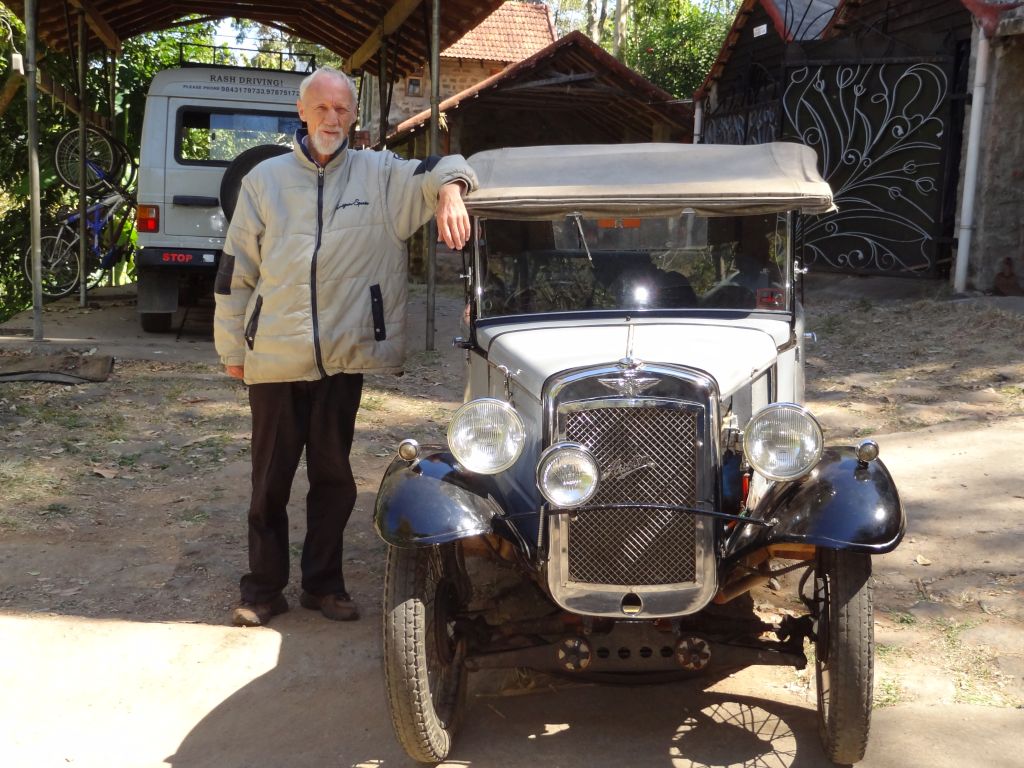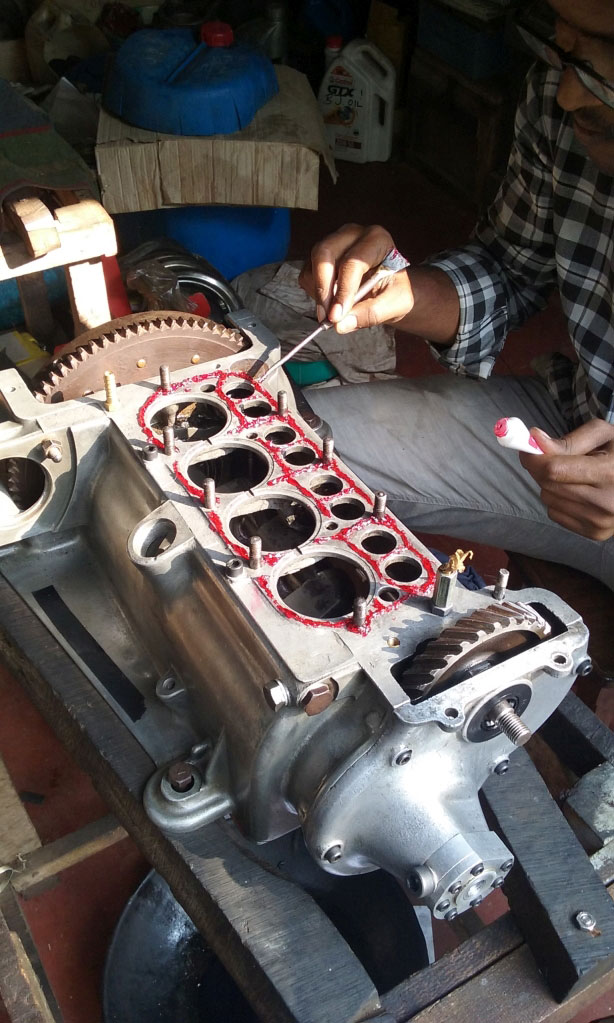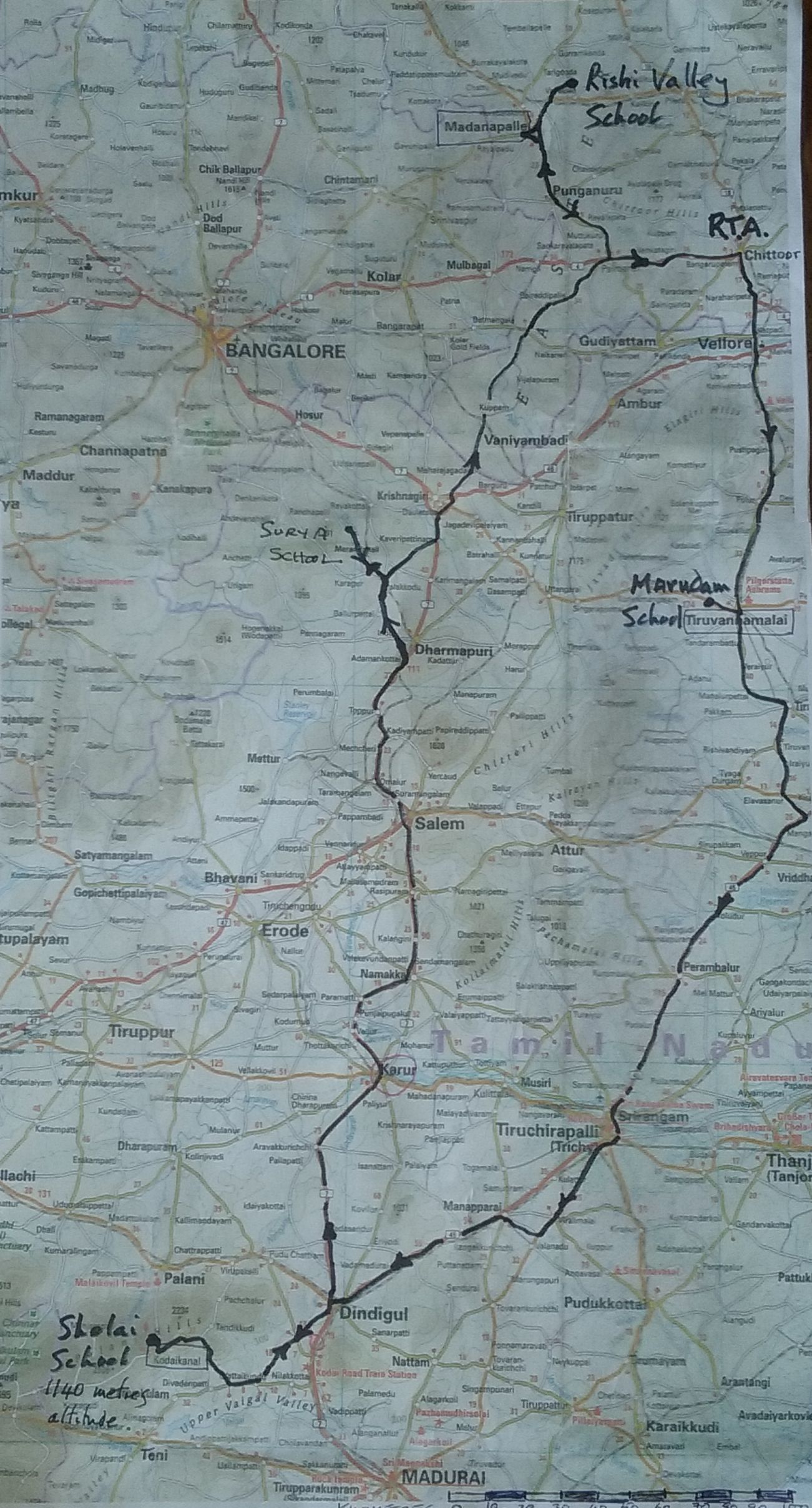|
by M.V. Duraipandy

The Austin, Mr.Jenkins and his Workshop in the Right Hand Corner

Mr. Brian Jenkins has asked me to write on this subject, since he realizes that very few people in India understand why he has spent so many years, either working alone, or working with some of the Sholai School students and a few of the staff members to create a good-looking and (we say) reliable, small vintage car.
He tells me that when he first came to India in earnest in 1986 (His first sojourn was in 1969, practising Buddhist Meditation at Bodhgaya), most people saw the Austin 7 as a cheap old car. “Poor chap”, they thought, “he cannot afford a better one”. The original plan was to drive overland from London, but it was much cheaper to send it in a small wooden box by sea to Bombay.
Nowadays the scenario is quite different. Many, many people try to “intercept” the car at the highway restaurants or on the highway itself, so as to take those ubiquitous “selfies”. Mr. Jenkins worries that in the excitement, there could be an accident. Once when he applied the brakes, an excited motorcyclist ran into the back of the Austin, damaging the wing, but no-one was hurt, so we will leave that issue.
I should say something briefly about myself, because the reader may wonder, concerning the objectivity of my reflections and iterations on Mr. Jenkins’s philosophy. Many years ago I came across J.Krishnamurti, I attended many of his talks and discussions. In effect I became steeped in his philosophy or “the teachings” as they are known. My family background was in Engineering but I became a social anthropologist. Hence I have travelled a lot and even toured by bicycle across Europe.
I was born a Brahmin, but many years ago I removed the thread. I understood from Krishnaji (the affectionate name often given to J.Krishnamurti) that it is essential to become acutely aware of ones conditioning and to go beyond it. As my (Brahmin) friend, Poornima of Marudam School in Thiruvannamalai (Tamilnadu) has observed, most Brahmins are used to managing people and telling others what to do. Very few are inclined to use their hands and be practical. I was like that.
It was only when I was riding my touring cycle across Europe that I began to learn the Art of being a practical engineer, thinking logically and being precise in maintaining and repairing the cycle. I must say Robert Pirsig’s brilliant book “Zen and the Art of Motorcycle Maintenance” played an important role in guiding me on this journey of learning.
Incidentally you may wonder how a Brahmin came to have the name: M. V. Duraipandy or in full: Munoo Virral Duraipandy. It is not relevant and I will not bore you with the details. However suffice to say, I have lived in Tamilnadu during the years of pro-Dravidian agitation and I did from time to time suffer abuse. In David Lean’s beautiful and philosophical film: “Dr.Zhivago”, the young Doctor Zhivago, himself declares that many of his class, had in the past, exploited the poor. In “A Tale of Two Cities”, Charles Dickens echoes the same sentiment, but he also conveys that there were some good aristocrats, caring for the people in their charge. Likewise there were some good Brahmins too.
The 1934 Austin 7
Then I discovered Sholai School and began to interact with Mr. Jenkins in the early 1990’s. In our conversations and my enquiries why he was working on such an old car, he told me a story. It is this.
After the 2nd World War many young Britishers were interested to build racing cars and to race them. The Austin 7 was designed by an 18 years old young man and built in 1922. It was the first “poor man’s car” in Europe. It was and still is the simplest car ever built. It was a great success. Many hundreds of thousands were built between 1922 and 1939 in UK, USA, Germany, Australia and Japan. Mr. Jenkins bought his first Austin 7 car in 1965 for £20. In today’s money: Rs.1700. Not much, even then! The post-war, mechanically-minded young British men, had almost no money, so they bought old Austin 7s, removed the bodies and turned them into racing cars or sports cars. They came to be known as “specials”.

Building the Engine

One among them was Colin Chapman who set up the Lotus Sports Car factory. His early learning took place, by designing and building Austin Seven specials. In particular he emphasized:“the power to weight ratio”. Every extra unnecessary ounce of weight should be eliminated in order to gain performance, he advised.
The early Austins had many design faults. So there are several books and websites on how to improve them. David Horsburgh, the well-known teacher and educationist at Rishi Valley and Neelbagh, both near Madanapalle in Andhra Pradesh, had 3 Austin Sevens. In order to avoid a drunken cyclist, one of his cars swerved and rolled over. David was in the passenger’s front seat. Sadly, as a result, he died 8 months later, aged 60. The front axle of Mr. Jenkins’s Austin has been modified and widened by 10 centimetres, so as to improve its road-holding considerably.
I have often given BJ (as I often call him) a hand when he was re-building the Austin. Practical mechanical engineering is a serious and demanding discipline. Careful attention is required to dismantle, fault-find and re-assemble every part of the car. Krishnaji happily tells us, he completely disassembled a car and reassembled it himself. He spoke of “the honest car”, a car one could repair oneself.
Modern cars cannot be rebuilt by an amateur, not even by a professional with his own hands. As modern machines, they require computers to design them, build them and diagnose faults. In my view they are not appropriate technologies.
Recently in December 2016, with two of his colleagues, Mr J. drove 1289 kilometres in the Austin 7, from Sholai School to Surya School another child-centric small school near Dharmapuri and thence to Rishi Valley School in Andhra Pradesh, the well-known J. Krishnamurti school. On the return journey they stayed overnight at Marudam Farm School near Thiruvannamalai. On the highways they were driving at 60 to 70 kilometres per hour (this was their actual speed; not according to an over-rated speedometer) and consumed 15.5 kilometres per litre of petrol. That compares well with the actual fuel consumption of modern cars. This is a rebuilt, modified 83 year old car. “So what?” you may say. “Old is gold” was the cynical telephone linesman’s comment... No, no, he has missed the point.

The Route Map

First consider building a car to be a serious educational exercise. Mr J.’s tryst with education in India has often focused on practice in the classroom: experimenting, collecting data, observing nature, leading to questions, dialogue, hypotheses and finally theories. Not beginning with theories, which lead to the religiosity and ossification of science and which is the way science is normally taught at most schools in our India. When working in Kenya at the age of 19, along with a young African, repairing Land Rovers, BJ built an electric motor using wood, wire and nails to demonstrate the functioning of the starter motor. Even the simplest motor car requires a knowledge of electricity, the thermo-syphon phenomenon, the mechanics of levers, hydraulics and the right stoichiometric ratio.
The amateur mechanic has to learn through trial and error, again and again, the importance of applying patient, logical processes. To take part in building a car is a creative endeavour for a young person at Sholai. I have seen teenage boys and girls fitting the 4 pistons into their cylinders. This is not a simple or easy thing to do. The gap between the piston and the cylinder bore should be, on assembly: 2 thousandths of an inch all-round. Very careful attention is required when fitting the connecting rods (the big-ends) to the crankshaft. If they are loose by 4 thousandths of an inch, the engine will start knocking and if unattended may break down totally with a hole in the side of the engine. This happened to the first Austin engine when the 81 year crankshaft broke, under speed.
The Stoichiometric Ratio is a crucial concept that anyone concerned with global warming and Anthropocenic issues needs to understand. The Anthropocene is a new word that recognises that we are living in a new age where the behaviour of human beings is radically impinging on the health and normal functioning of Planet Earth. The Stoichiometric ratio is simple to understand. Whenever there is an intentionally created, artificial fire or explosion, the ratio of fuel to air needs to be just right. Of course sufficient heat is also required. For example in an internal combustion engine, petrol or diesel, the stoichiometric ratio is approximately 13:1. That is 13 kilos of Air to 1 kilo of petrol. If there is too much petrol the engine will smoke. If there is too much air the engine may overheat and/or lack power.
Similarly, traditional wood-burning stoves are not designed properly, so they smoke, causing respiratory problems in human beings, air pollution of the planet and consume excessive firewood. The recent invention: “The Rocket Stove” is smokeless, it is abstemious in the use of firewood and is Planet Earth-friendly. It has been carefully designed to produce the correct stoichiometric ratio. It is such a pity that this concept is not taught in our Schools.
At Sholai School, it is now true to say that almost all of the wood-burning stoves are efficient and smokeless. There are 5 stoves for heating bath water for the students, staff and guests and 7 stoves for cooking in the kitchens. They may smoke for a short while, but once hot, their smokeless exhausts are a joy to behold. The most recent refined creation is the “Vatlagundu Thosai Stove” which can cook 8 Thosai in around 4 minutes. It has the right stoichiometric ratio..... therefore there is no smoke.
BJ also tells me that as a school Principal and a man who loves Nature, he spends much of his time either talking with his technical staff or his teachers, or the students, or in reading and writing. To take a break from all this “ferment of intellectual endeavour”, (a phrase from social anthropology), is a deeply felt need. Building “an honest car” provides him with that opportunity; even though, when he began his learning journey, he told me, working on the Austin was almost as difficult as human relationships!
Remember the students too. Sitting through class after class, even if they are well taught, for nigh on 7 hours, 6 days a week; definitely they need a break. Years ago I remember Bhanu, a 15 year old Sholai School student telling me that after the Organic Farming class, her attention span in her academic classes was much enhanced. The practical Engineering classes are also helpful in linking daily life with their academic studies of Maths and Science. They also provide that much needed break from academics.
If I may share my own personal experience with BJ; after we lowered the engine into the chassis, my job was to reconnect the positive wire from the 12 volt battery to the starter motor. Inadvertently and carelessly I connected a negative wire to the starter motor as well. BJ then turned on the battery switch. Much smoke arose from the bonnet, quickly he switched off; had he delayed a moment longer a fire would have ensued. He was patient and calm with me, explaining my error. He went further. “I might well have made the same mistake, myself,” he said. We had to replace the starter switch and a length of heavy burnt copper wire.
You may be interested to know that he has a string of gurus who have guided him in improving the Austin 7, advising him when he has been in doubt. Alex (42) runs a small company in UK, building Austin 7 racing cars, he and his father: Tim (78), an Aeronautical Engineer are always ready with helpful advice over the mobile phone. Chris (74), who holds the land speed record for 5000 miles in an Austin 7 special has spent many hours of his time advising BJ over the telephone. Here in India the late Professor Soundranayakam of the Indian Institute of Science, was a good friend and another engineering guru and Subhash (48) of Hyderabad is an expert in electrical matters. There are many others. Currently Dr. Asma Ahmed is researching the extraction of methanol from the Palani Hill grasses, that can be used as a renewable bio-fuel, unlike petrol: which is non-renewable. One day the Austin may run on bio-petrol. Let us see.
Dear Reader, do you now appreciate that the Austin 7 plays an important role in the education of young people?
~ M.V. Duraipandy
|







